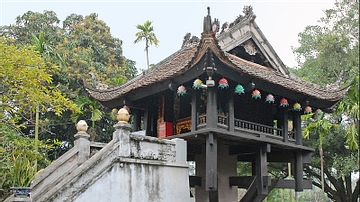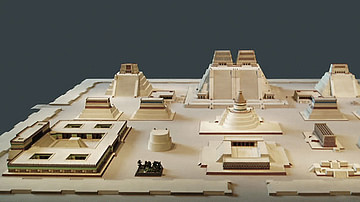Search Images
Browse Content (p. 1725)

Image
Clodius Albinus
A marble bust of Clodius Albinus (150-197 CE) who, on the death of Pertinax in 193 CE, was declared Roman emperor by the legions in Britain and Hispania. (Capitoline Museums, Rome)

Image
Bias of Priene
A marble herm bust of the Greek 4th century BCE orator Bias of Priene. Considered one of the seven sages his famous motto was 'Most men are bad'. Roman copy of the Hadrian period from a Greek original. (Vatican Museums, Rome)

Image
Constantius Chlorus
A bust of Roman emperor Constantius Chlorus (r. 305-306 CE) who was the father of Constantine the Great. (Vatican Museums, Rome)

Image
Demosthenes, Vatican Museums
A marble bust of the 4th century BCE Athenian politician Demosthenes. 2nd century CE from a Greek original by Polyeuktos c. 280 BCE. (Vatican Museums, Rome)

Image
Mot Cot Pagoda
Mot Cot Pagoda is a pagoda in the center of Hanoi. It was built in 1049 CE by Li Thanh Tong King. The temple is constructed of wood on a single stone pillar 1.25 m in diameter, and it is designed to resemble a lotus blossom, which is a Buddhist...

Image
Sophocles
A bust of Sophocles (497/6 - 406 BCE) the Greek tragic poet and author of such masterpieces of Greek Tragedy as 'Oedipus the King'. Second half of the 1st century BCE. (Vatican Museums, Rome)

Image
Tizoc Stone
The Tizoc Stone which depicts on its flat upper surface a sun-disk and around its edge a continuous frieze showing the Aztec king Tizoc and other warriors capturing deities of conquered peoples. 15th century CE. (National Museum of Anthropology...

Image
First English version of Euclid's Elements, 1570
Title page of Sir Henry Billingsley's first English version of Euclid's Elements, 1570.

Image
Sacred Precinct, Tenochtitlan
A model reconstruction of the sacred precinct of Tenochtitlan, the Aztec capital on Lake Texcoco. The city was founded in 1345 CE and fell to the Spanish forces led by Cortés in 1521 CE. The sacred complex was dominated by the central pyramid...

Image
Temple Mayor, Tenochtitlan
A model reconstruction of the Temple Mayor at the Aztec capital of Tenochtitlan. In use from the 14th to early 16th century CE, the huge pyramid was topped by two temples, one dedicated to Tlaloc, the god of rain (north side), the other to...